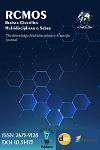Defining and Managing KPIs for Logistics Optimization: A Critical Analysis of Container Utilization Rate, Cost per Transported Unit, and GHG Emissions
Defining and Managing KPIs for Logistics Optimization: A Critical Analysis of Container Utilization Rate, Cost per Transported Unit, and GHG Emissions
DOI:
https://doi.org/10.51473/rcmos.v1i1.2025.1421Keywords:
logistics; KPIs; container; logistics costs; emissions; GHG.Abstract
This article discusses the design and governance of key performance indicators (KPIs) in intermodal logistics operations, focusing on three key metrics: container utilization rate, cost per unit transported, and greenhouse gas (GHG) emissions. A framework is proposed that integrates rigorous operational definition, data standardization, collection methods, and managerial use anchored in trade-offs between efficiency, resilience, and sustainability. The analysis articulates literature on operations management, transportation economics, and carbon accounting, highlighting how seemingly technical choices—such as denominators, measurement windows, cargo mix, and emissions scopes—alter the performance narrative and capital allocation (CHRISTOPHER, 2016; CHOPRA; MEINDL, 2016; UNCTAD, 2020; WORLD BANK, 2020; GHG PROTOCOL, 2011; SMART FREIGHT CENTRE, 2019).
Downloads
References
CHOPRA, S.; MEINDL, P. Supply Chain Management: Strategy, Planning, and Operation. 6. ed. Boston: Pearson, 2016.
CHRISTOPHER, M. Logistics & Supply Chain Management. 5. ed. Harlow: Pearson, 2016.
CLARKSONS RESEARCH. Container Intelligence Quarterly. London: Clarksons Research, 2021.
DREWRY. Container Forecaster. London: Drewry Maritime Research, 2021.
EIA – U.S. ENERGY INFORMATION ADMINISTRATION. Short-Term Energy Outlook. Washington, DC: EIA, 2021.
EN 16258. Methodology for Calculation and Declaration of Energy Consumption and GHG Emissions of Transport Services (freight and passengers). Brussels: CEN, 2012.
GHG PROTOCOL. Corporate Value Chain (Scope 3) Accounting and Reporting Standard. Washington, DC: WRI/WBCSD, 2011.
HARALAMBIDES, H. E. Gigantism in container shipping, ports and global logistics: a time-lapse into the future. Maritime Economics & Logistics, v. 21, p. 1–60, 2019. DOI: https://doi.org/10.1057/s41278-018-00116-0
IAPH – INTERNATIONAL ASSOCIATION OF PORTS AND HARBORS. COVID-19 Port Economic Impact Barometer. Antwerp: IAPH, 2020.
IMO – INTERNATIONAL MARITIME ORGANIZATION. IMO 2020 Sulphur Cap: Guidance and Impacts. London: IMO, 2020.
ISO. ISO 22301:2019 — Security and Resilience — Business Continuity Management Systems — Requirements. Genebra: ISO, 2019.
IVANOV, D.; DOLGUI, A. Viability of intertwined supply networks: extending the supply chain resilience angles. International Journal of Production Research, v. 58, n. 10, p. 2904–2915, 2020. DOI: https://doi.org/10.1080/00207543.2020.1750727
KAPLAN, R. S.; ANDERSON, S. R. Time-Driven Activity-Based Costing: A Simpler and More Powerful Path to Higher Profits. Boston: Harvard Business School Press, 2007.
NOTTEBOOM, T.; PALLIS, A. Port Economics, Management and Policy: COVID-19 and the impact on ports. Relatórios/briefs, 2020. DOI: https://doi.org/10.4324/9780429318184
NOTTEBOOM, T.; RODRIGUE, J.-P. Port congestion and the destabilization of supply chains in 2020/2021. Maritime Economics & Logistics, 2021.
OECD/ITF – INTERNATIONAL TRANSPORT FORUM. Policies to Enhance Intermodal Connectivity and Performance. Paris: OECD Publishing, 2016.
PONOMAROV, S. Y.; HOLCOMB, M. C. Understanding the concept of supply chain resilience. The International Journal of Logistics Management, v. 20, n. 1, p. 124–143, 2009. DOI: https://doi.org/10.1108/09574090910954873
RODRIGUE, J.-P. The Geography of Transport Systems. 4. ed. New York: Routledge, 2020. DOI: https://doi.org/10.4324/9780429346323
SEA-INTELLIGENCE MARITIME ANALYSIS. Global Liner Performance (GLP) Report. Copenhagen: Sea-Intelligence, 2021.
SHEFFI, Y. The Power of Resilience: How the Best Companies Manage the Unexpected. Cambridge, MA: MIT Press, 2015. DOI: https://doi.org/10.7551/mitpress/9780262029797.001.0001
SMART FREIGHT CENTRE. Global Logistics Emissions Council (GLEC) Framework. Amsterdam: SFC, 2019.
UNCTAD – UNITED NATIONS CONFERENCE ON TRADE AND DEVELOPMENT. Review of Maritime Transport 2020. Geneva: UNCTAD, 2020.
WORLD BANK; IHS MARKIT. Container Port Performance Index 2020. Washington, DC: World Bank, 2020.
Downloads
Additional Files
Published
Issue
Section
Categories
License
Copyright (c) 2025 Ivan de Matos (Autor)

This work is licensed under a Creative Commons Attribution 4.0 International License.












